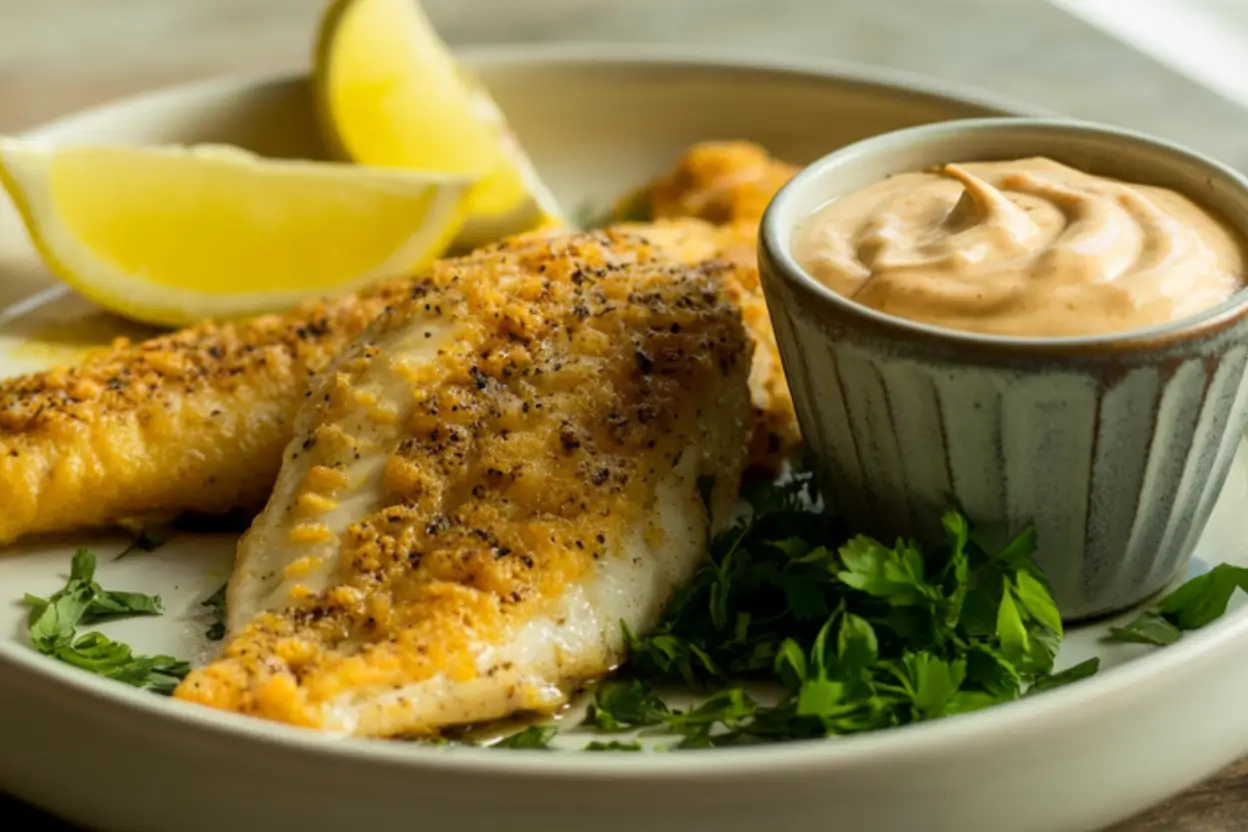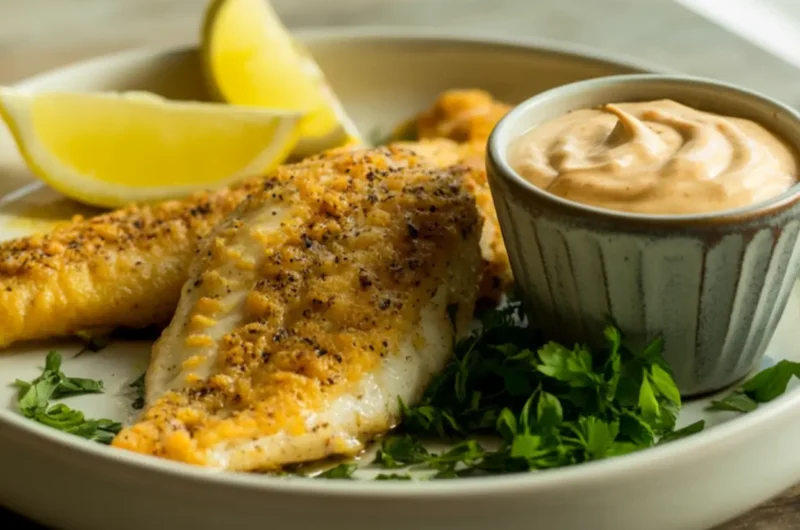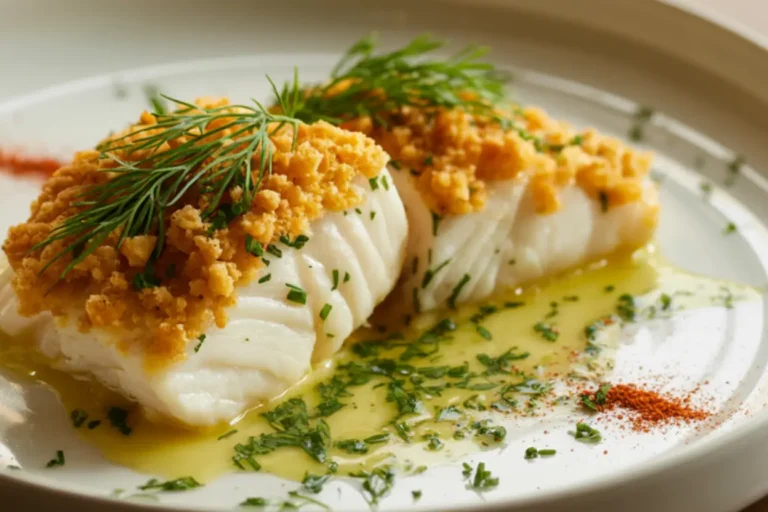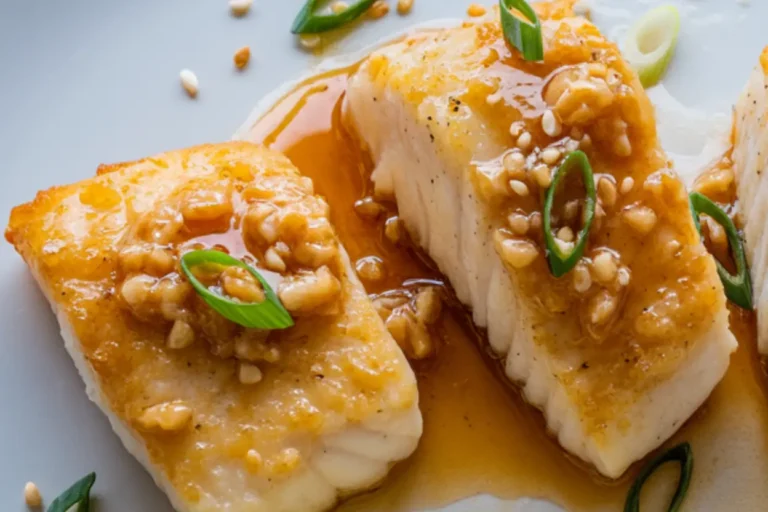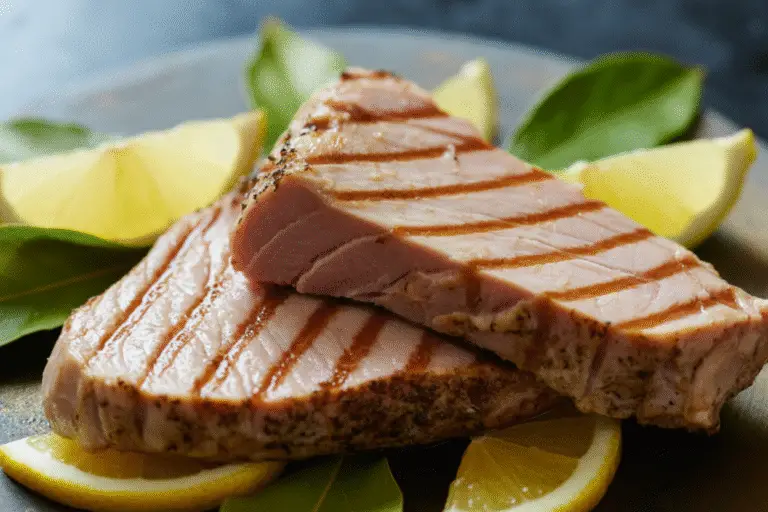Pan-Fried Catfish Recipe: How to Nail That Southern Crunch
Table of Contents
If there’s one dish that captures the soul of Southern cooking, it’s perfectly pan-fried catfish. Having grown up with a fishing rod in one hand and a cast iron skillet in the other, I’ve spent years perfecting the technique that delivers that signature golden crust while keeping the fish tender and flaky inside. Today, I’m sharing my tried-and-true method that will transport your taste buds straight to a Mississippi fish fry, no matter where you’re cooking.
Thank you for reading this post, don't forget to subscribe!How to Make Pan-Fried Catfish:
Quick Overview
This pan-fried catfish recipe delivers everything you want in Southern-style fish: a crispy, well-seasoned cornmeal crust that audibly crunches when you bite into it, revealing moist, flaky fish with a clean, mild flavor. What makes this version special is the balanced seasoning blend that complements rather than overwhelms the delicate catfish, plus a foolproof dredging technique that ensures your coating stays put during frying.
The beauty of pan-fried catfish lies in its simplicity. With just a handful of pantry staples and fresh fish, you can create a restaurant-quality meal in minutes. From start to finish, this recipe takes about 30 minutes, with only 10 minutes of active preparation time. The actual cooking goes quickly—just 3-4 minutes per side—making this an excellent option for a satisfying weeknight dinner when you want something special without spending hours in the kitchen.
The Ingredients I Use to Bring My Pan-Fried Catfish to Life
For the catfish (serves 4):
- 4 U.S. farm-raised catfish fillets (about 6 ounces each), patted dry
- 1 cup buttermilk
- 1 large egg
- 1 tablespoon hot sauce (preferably Louisiana-style)
- 1 cup yellow cornmeal (medium grind)
- 1/2 cup all-purpose flour
- 1 tablespoon Cajun or Creole seasoning
- 1 teaspoon garlic powder
- 1 teaspoon onion powder
- 1 teaspoon paprika
- 1/2 teaspoon salt
- 1/2 teaspoon black pepper
- 1/4 teaspoon cayenne pepper (adjust according to heat preference)
- Vegetable oil or peanut oil for frying (approximately 1/2 inch depth in pan)
- Lemon wedges for serving
For the optional remoulade sauce:
- 1/2 cup mayonnaise
- 1 tablespoon Dijon mustard
- 1 tablespoon sweet pickle relish
- 1 tablespoon fresh lemon juice
- 1 teaspoon Worcestershire sauce
- 1 teaspoon hot sauce
- 1 small garlic clove, minced
- 1 tablespoon fresh parsley, finely chopped
- 1 green onion, finely chopped
- 1/4 teaspoon paprika
- Salt and pepper to taste
Step-by-Step Instructions
Preparing the Fish
- Inspect and prepare the catfish fillets: Examine each fillet for any remaining bones by running your fingers gently over the surface. Remove any bones with fish tweezers or clean needle-nose pliers. Rinse fillets under cold water and pat thoroughly dry with paper towels.
- Make the buttermilk soak: In a shallow dish large enough to hold all the fillets, whisk together the buttermilk, egg, and hot sauce until well combined. This mixture will help the coating adhere while adding flavor and keeping the fish moist.
- Soak the catfish: Place the fillets in the buttermilk mixture, ensuring they’re completely submerged. Let them soak for at least 15 minutes (or up to 1 hour in the refrigerator if you have time). This step tenderizes the fish and removes any lingering muddy taste.
Creating the Perfect Coating
- Prepare your dredging station: While the fish soaks, combine the cornmeal, flour, Cajun seasoning, garlic powder, onion powder, paprika, salt, black pepper, and cayenne in a shallow dish or baking pan. Whisk thoroughly to ensure even distribution of seasonings.
- Set up your frying area: Line a large plate with paper towels and place a wire cooling rack on top. This setup allows excess oil to drain while keeping the fried fish crispy. Have a slotted spatula or spider ready for removing the fish from the oil.
The Dredging Process
- Heat the oil: Pour vegetable or peanut oil into a large, heavy skillet (cast iron is ideal) to a depth of about 1/2 inch. Heat over medium-high heat until it reaches 350-375°F (177-190°C). If you don’t have a thermometer, test by sprinkling a pinch of cornmeal into the oil—it should sizzle immediately but not burn.
- Dredge the catfish: Remove one fillet at a time from the buttermilk mixture, allowing excess liquid to drip off. Place it directly into the cornmeal mixture and press the coating firmly onto all sides of the fish. Gently shake off any excess coating.
- Rest before frying: Place the coated fillet on a clean plate and repeat with the remaining fillets. Let the coated fish rest for 2-3 minutes to help the coating adhere better.
Frying to Golden Perfection
- Fry the catfish: Carefully slide 2 fillets into the hot oil (don’t overcrowd the pan). The oil should bubble actively around the fish but not violently. Adjust the heat as needed to maintain the temperature.
- Monitor and flip: Fry for 3-4 minutes on the first side until golden brown. Using your slotted spatula, carefully flip each fillet and cook for an additional 3 minutes on the second side, or until the coating is crispy and the fish flakes easily with a fork.
- Drain and keep warm: Transfer the fried fillets to your prepared cooling rack. If desired, sprinkle with a touch more salt while hot. Keep warm in a 200°F oven while frying the remaining fillets.
- Fry the remaining fish: Bring the oil back to temperature, then repeat steps 9-11 with the remaining fillets. Check the oil temperature between batches and adjust the heat as needed.
Optional: Make the Remoulade Sauce
- Combine ingredients: While the fish cooks or rests, whisk together all remoulade sauce ingredients in a small bowl until well-combined.
- Chill briefly: Cover and refrigerate the sauce for at least 15 minutes (if time allows) to let the flavors meld.
Serve and Enjoy
- Plate your creation: Arrange the catfish fillets on serving plates, add lemon wedges for squeezing, and serve with remoulade sauce on the side. Garnish with a sprinkle of chopped parsley if desired.
What to Serve Pan-Fried Catfish With
Pan-fried catfish shines brightest when paired with complementary sides that balance its rich, crispy texture. Here are some classic and creative options:
Traditional Southern Sides:
- Creamy coleslaw with a tangy vinegar dressing
- Hush Puppies (deep-fried cornmeal fritters)
- Collard greens seasoned with smoked ham hock
- Buttery skillet cornbread
- Red beans and rice
- Homemade mac and cheese
Lighter Accompaniments:
- Sliced tomatoes with a drizzle of olive oil and fresh basil
- Cucumber and onion salad with vinegar dressing
- Pickled vegetables (okra, green tomatoes, or chow-chow relish)
- Simple green salad with buttermilk ranch dressing
- Roasted Brussels sprouts with bacon
Starch Options:
- Classic French fries or sweet potato fries
- Cheese grits (a Southern breakfast staple that pairs beautifully with fish)
- Potato salad with mustard dressing
- Dirty rice with finely chopped chicken livers and bell pepper
Sauce Pairings:
- Homemade tartar sauce
- The remoulade sauce included in this recipe
- Hot sauce (Crystal, Louisiana, or Tabasco are all authentic choices)
- Comeback sauce (a Mississippi specialty similar to remoulade)
Beverage Suggestions:
- Sweet tea (the quintessential Southern drink)
- Cold beer (try a light lager or a wheat beer)
- Lemonade
- Sauvignon Blanc or unoaked Chardonnay, if you prefer wine
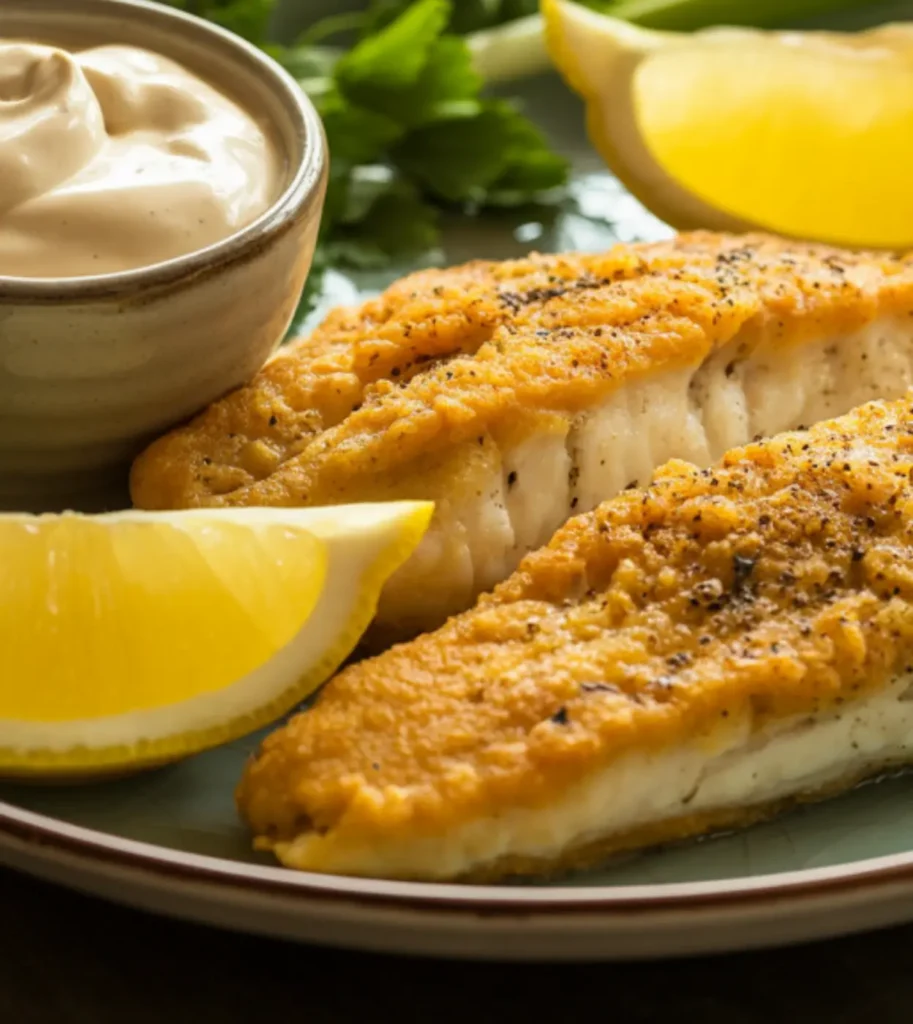
Top Tips for Perfecting Pan-Fried Catfish
After years of frying countless catfish fillets, I’ve gathered these invaluable tips that will help you achieve fish fry perfection:
Fish Selection and Preparation:
- Choose the right catfish: U.S. farm-raised catfish is consistently mild in flavor and sustainably produced. Look for fillets that are pinkish-white with no strong odor.
- Size matters: Medium fillets (5-7 ounces) cook more evenly than very large ones. If you have larger fillets, consider cutting them in half or adjusting cooking time accordingly.
- Freshness indicators: Look for firm flesh that springs back when pressed, clear eyes (if buying whole fish), and minimal “fishy” aroma.
- Thoroughly dry the fish: After rinsing, pat the fillets completely dry with paper towels. Excess moisture creates steam, preventing proper browning and causing the coating to slide off.
Coating Techniques:
- Don’t skip the buttermilk soak: This crucial step not only helps the coating adhere but also neutralizes any muddy taste that wild-caught catfish might have.
- Cornmeal ratio matters: The 2:1 ratio of cornmeal to flour creates the perfect texture—crunchy but not gritty. For an even crunchier result, use stone-ground cornmeal.
- Season aggressively: The coating needs plenty of seasoning since many spices remain in the coating rather than penetrating the fish.
- One-hand, two-hand method: Use one “wet” hand for the buttermilk mixture and one “dry” hand for the cornmeal mixture to prevent creating gunky fingers that will clump the coating.
Frying Wisdom:
- Oil temperature is critical: Too hot (above 375°F), and the coating burns before the fish cooks; too cool (below 350°F), and the fish absorbs oil, becoming greasy. An instant-read or candy thermometer is worth the investment.
- Choose the right oil: Peanut oil is traditional and has a high smoke point, but vegetable oil or canola oil work well too. Avoid olive oil, which has too low a smoke point.
- Don’t overcrowd the pan: Frying too many pieces at once lowers the oil temperature dramatically, resulting in soggy fish. Work in batches instead.
- Maintain oil temperature: Allow the oil to return to 350-375°F between batches for consistent results.
- Control oil spattering: To minimize splatter, slide the fish into the oil away from you, gently lowering one end first rather than dropping it in.
Troubleshooting Common Issues:
- Coating falling off? Ensure fish is dry before soaking, let excess buttermilk drip off, and allow the coated fish to rest before frying.
- Too greasy? Your oil likely wasn’t hot enough. Check with a thermometer and allow the oil to heat adequately between batches.
- Fish curling up? Make shallow cuts through the skin side (about 1/4 inch deep) before coating to prevent this.
Storing and Reheating Tips
While pan-fried catfish is unquestionably best enjoyed hot from the skillet, sometimes you’ll have leftovers. Here’s how to make the most of them:
Short-Term Storage:
- Allow leftover catfish to cool completely at room temperature (but not for more than 30 minutes).
- Place in an airtight container, separating layers with parchment paper to prevent sticking.
- Refrigerate for up to 2 days. Beyond that, quality significantly deteriorates.
- Store any leftover remoulade sauce separately in an airtight container for up to 5 days.
Freezing (If Necessary):
- While not ideal, you can freeze fried catfish if needed.
- Place cooled pieces on a parchment-lined baking sheet and freeze until solid (about 2 hours).
- Transfer to a freezer-safe container or heavy-duty freezer bag with parchment between layers.
- Frozen fried catfish can be kept for up to 1 month, though the texture quality will diminish somewhat.
Reheating Methods:
For Best Results (Oven Method):
- Preheat your oven to 350°F (175°C).
- Place refrigerated catfish on a wire rack set over a baking sheet.
- For extra crispiness, lightly spray or brush with a small amount of oil.
- Heat for 10-12 minutes until warmed through and somewhat crispy again.
Quick Option (Air Fryer):
- Preheat air fryer to 350°F (175°C).
- Place catfish in the basket in a single layer.
- Reheat for 3-4 minutes until hot and crispy.
If Frozen:
- Thaw in the refrigerator overnight for best results.
- Reheat using the oven method, adding 3-5 minutes to the reheating time.
Avoid the Microwave If Possible:
- Microwaving will make the coating soggy and can give the fish a rubbery texture.
- If you must use a microwave, place the fish on a microwave-safe plate, cover with a paper towel, and heat on 50% power in 30-second intervals until just warmed through.
With these detailed instructions and insider tips, you’re well-equipped to create authentic Southern pan-fried catfish with that perfect crispy coating and tender, flaky interior that would make any Mississippi grandma proud. This simple yet satisfying dish proves that sometimes the most humble ingredients, when prepared with care and knowledge, create the most memorable meals. Enjoy your homemade pan-fried catfish—and don’t forget the hot sauce!
click here to follow me on pinterest
Pan-Fried Catfish Recipe: How to Nail That Southern Crunch
Cuisine: Southern AmericanDifficulty: Moderate4
servings20
minutes20
minutes550-650
kcalThis Southern classic delivers crispy, golden catfish fillets with a bold, seasoned crust and a tender, flaky interior. Marinated in a flavorful buttermilk bath and dredged in a spiced cornmeal-flour coating, each bite packs a satisfying crunch. Served with a zesty homemade remoulade, this dish is a crowd-pleaser that celebrates the bold flavors of Cajun and Creole cuisine.
Ingredients
4 U.S. farm-raised catfish fillets (about 6 ounces each), patted dry
1 cup buttermilk
1 large egg
1 tablespoon hot sauce (preferably Louisiana-style)
1 cup yellow cornmeal (medium grind)
1/2 cup all-purpose flour
1 tablespoon Cajun or Creole seasoning
1 teaspoon garlic powder
1 teaspoon onion powder
1 teaspoon paprika
1/2 teaspoon salt
1/2 teaspoon black pepper
1/4 teaspoon cayenne pepper (adjust according to heat preference)
Vegetable oil or peanut oil for frying (approximately 1/2 inch depth in pan)
Lemon wedges for serving
1/2 cup mayonnaise
1 tablespoon Dijon mustard
1 tablespoon sweet pickle relish
1 tablespoon fresh lemon juice
1 teaspoon Worcestershire sauce
1 teaspoon hot sauce
1 small garlic clove, minced
1 tablespoon fresh parsley, finely chopped
1 green onion, finely chopped
1/4 teaspoon paprika
Salt and pepper to taste
Instructions
- Prepare the Catfish
-Check fillets for bones and pat them dry.
-In a shallow dish, whisk together buttermilk, egg, and hot sauce.
-Submerge the fillets in the mixture and let them soak for 15 minutes to 1 hour in the fridge.
This tenderizes the fish and enhances flavor. - Mix the Coating and Set Up the Frying Station
-In another dish, mix cornmeal, flour, Cajun seasoning, garlic powder, onion powder, paprika, salt, pepper, and cayenne.
-Prepare a plate lined with paper towels and a wire rack for draining.
-Preheat about ½ inch of vegetable or peanut oil in a heavy skillet to 350–375°F (177–190°C). - Dredge the Fish
-Remove fillets from the buttermilk, let excess drip off.
-Dredge each in the cornmeal-flour mixture, pressing gently to coat.
-Let coated fillets rest on a plate for 2–3 minutes to help the crust stick. - Fry the Catfish
-Carefully place 2 fillets in the hot oil at a time.
-Fry for 3–4 minutes per side, or until golden brown and the fish flakes easily.
-Transfer to the wire rack, season lightly with salt if desired.
-Keep warm in a 200°F oven while frying the remaining fillets. - Make the Sauce and Serve
-Mix all remoulade sauce ingredients in a small bowl and chill for 15 minutes.
-Serve catfish hot with lemon wedges, remoulade, and optional fresh parsley garnish.
Notes
- This dish showcases the essence of Southern comfort food with its spiced cornmeal crust and rich remoulade sauce. U.S. farm-raised catfish is ideal for its mild, sweet flavor and sustainability. The remoulade adds a tangy, creamy contrast, and you can easily tweak the heat level by adjusting the hot sauce and cayenne. For the best results, serve immediately with lemon wedges and sides like coleslaw, cornbread, or fries.

